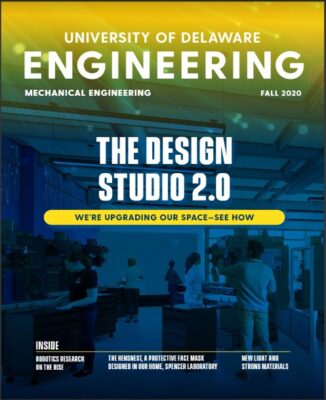UD mechanical engineer reports capacitor advance, which could help electronic device components
In the 1960s, mainframe computers took up entire rooms. By the 1980s, there were individual workstations and just a few decades later, laptops and smartphones became ubiquitous. Today’s technology is smaller still: millimeter-scale sensors far tinier than a penny enable highly integrated circuits to power our electronics and other devices.
Consumers continue to demand devices that are smaller, faster and more powerful than before. They want multi-functionality, too. Consider smartphones, it’s not enough for the device to enable a phone call, it also needs to serve as a handheld computer, television and gaming system.
One limiting factor for the miniaturization of many electronics is the size of the internal components that comprise them.
University of Delaware mechanical engineer Bingqing Wei and colleagues have targeted their research to a specific component in electronics called a filter capacitor. Wei explained that alternating current (AC) electricity often must be converted into a direct current (DC) signal to operate our televisions, computers, appliances, smartphones and other small electronics.
“Devices need a constant current. The filter capacitor does this work of converting the AC signal,” said Wei, professor of mechanical engineering and director of the Center for Fuel Cells and Batteries at UD.
Important for a device’s function, filter capacitors are found on electronic circuits, alongside other components such as diodes or transistors that help the electrical current flow. They work at any frequency, including the 120 hertz frequency range where most of today’s devices operate.
The most used filter capacitor today is the aluminum electrolytic capacitor, which offers high-power and fast frequency response. Its shortcomings are that it is big in size and cannot store large amounts of energy. Wei and his colleagues have been looking for a higher-energy substitute that will do the job.
The researchers recently demonstrated that using a carbon tube grid-based capacitor is a promising way to overcome this limiting factor that causes today’s capacitors to be slow.
“By using a grid-based system made of a 3D tightly interconnected carbon network, the filter capacitor can hold a very high amount of energy in a smaller package,” said Wei. “This means faster moving current and better performance for our small devices, without interference or unwanted frequency or disruption.”
The research team recently reported their results in Science.
Previous work leads to new research
A capacitor consists of an electrolyte sandwiched between two conducting metal plates, called electrodes. The microstructure of the electrodes plays a crucial role in determining how well the capacitor performs. In this current work, Wei has been working to design electrode structures with 3D-interconnected channels that would allow electrical current to flow quickly while simultaneously enabling the capacitor to store high-energy electric charges at frequencies around 120 Hz.
It’s an area he has been exploring in his research for over 20 years. In previous work, he and colleagues found that capacitors with better electrical-conducting channels promote the movement of electrical current through devices and can promote high energy storage capacity. Typically, this has been done by aligning carbon nanotubes only in a single direction, say vertically. So, the research team decided to try to interconnect the vertical tubes with horizontal tubes to help the electrical current move more quickly via a three-dimensional interconnected network.
The research team began with a template of pure aluminum containing vertical channels. They oxidized the aluminum template, introducing beneficial impurities that chiseled horizontal holes in the structure’s existing vertical tubes, creating an interconnected network. When the impurities were removed, the researchers were left with a 3D template of vertically and horizontally integrated holes (channels). The research team deposited carbon tubes into the template holes, then used a sodium-hydroxide solution to etch the template away, leaving behind a freestanding flexible film of interconnected 3D carbon tubes.
They then tested the performance of three different types of carbon-nanotube networks:
- a regular 3D carbon-tube network,
- a 3D carbon-tube network treated with an acid solution to increase the material’s surface roughness, and
- a 3D carbon-tube network that had been immersed in a nickel-salt solvent to create additional smaller nanotubes inside the carbon tubes.
In their experiments, the research team measured the ability of each network to control the frequency’s performance. While all three structures performed similarly, the rough-surface 3D carbon tube performed the best, which Wei attributed to increased available surface area to allow more energy storage.
When they compared the frequency response of each sample to current state-of-the-art technology, they found that all samples exhibited high energy capacity. In addition, the capacitors can be connected in series to increase the operating voltage several-fold without sacrificing their electrochemical performance at the high frequency.
“This tells us that the flexible two-tiered carbon nanotube structure provides the same quality of frequency response as current commercial technology, but its tightly integrated structure enables it to be made into smaller devices,” said Wei.
In practice, Wei said the researcher’s design could provide the ability to create filter capacitors that are at least 100 times (two orders of magnitude) smaller, maybe even 1,000 times smaller than what is available today, while offering the same or better storage capacity at high frequencies.
Next steps in the work include developing a demonstration device to integrate the proposed capacitor with other components for multi-functional smart devices.
Article by Karen B. Roberts | Photo illustration by Jeffrey C. Chase | November 01, 2022


